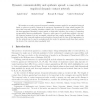Free Online Productivity Tools
i2Speak
i2Symbol
i2OCR
iTex2Img
iWeb2Print
iWeb2Shot
i2Type
iPdf2Split
iPdf2Merge
i2Bopomofo
i2Arabic
i2Style
i2Image
i2PDF
iLatex2Rtf
Sci2ools
CORR
2016
Springer
2016
Springer
Dynamic communicability and epidemic spread: a case study on an empirical dynamic contact network
We analyze a recently proposed temporal centrality measure applied to an empirical network based on person-to-person contacts in an emergency department of a busy urban hospital. We show that temporal centrality identifies a distinct set of top-spreaders than centrality based on the time-aggregated binarized contact matrix, so that taken together, the accuracy of capturing top-spreaders improves significantly. However, with respect to predicting epidemic outcome, the temporal measure does not necessarily outperform less complex measures. Our results also show that other temporal markers such as duration observed and the time of first appearance in the the network can be used in a simple predictive model to generate predictions that capture the trend of the observed data remarkably well.
| Added | 01 Apr 2016 |
| Updated | 01 Apr 2016 |
| Type | Journal |
| Year | 2016 |
| Where | CORR |
| Authors | Isabel Chen, Michele Benzi, Howard H. Chang, Vicki S. Hertzberg |
Comments (0)

